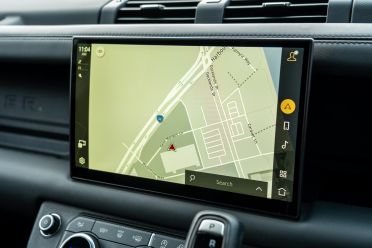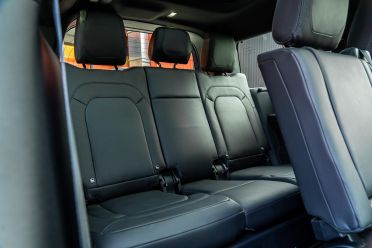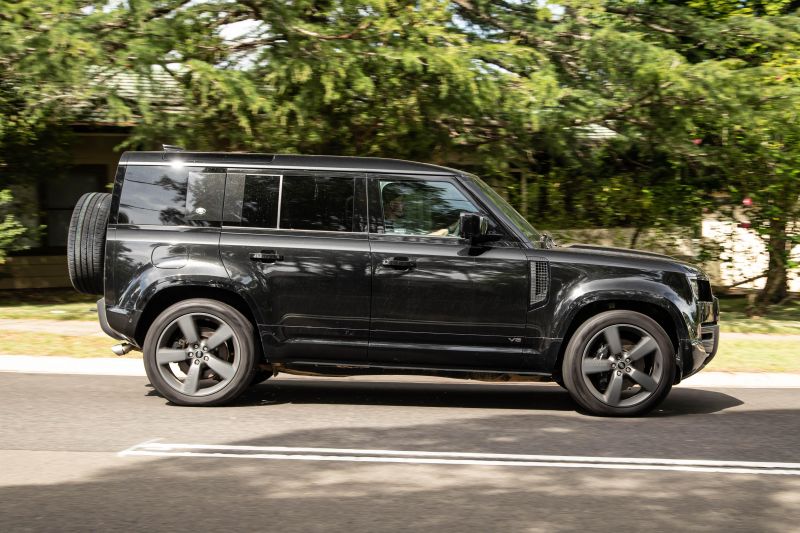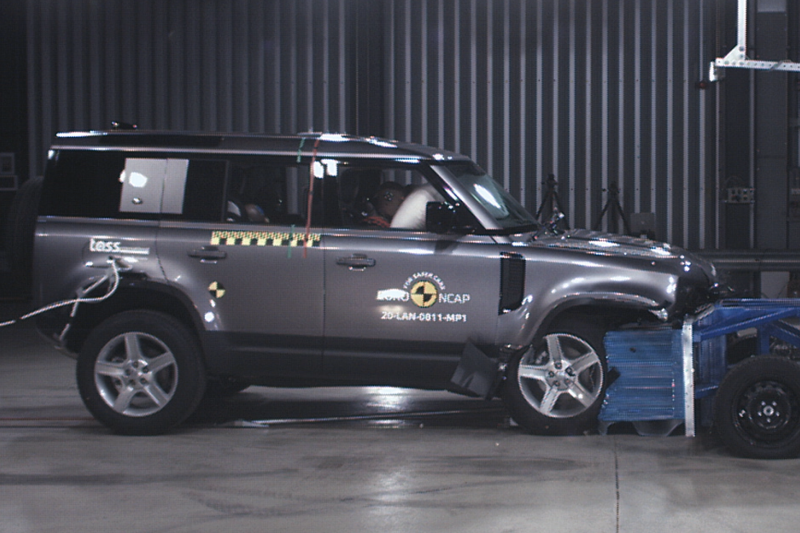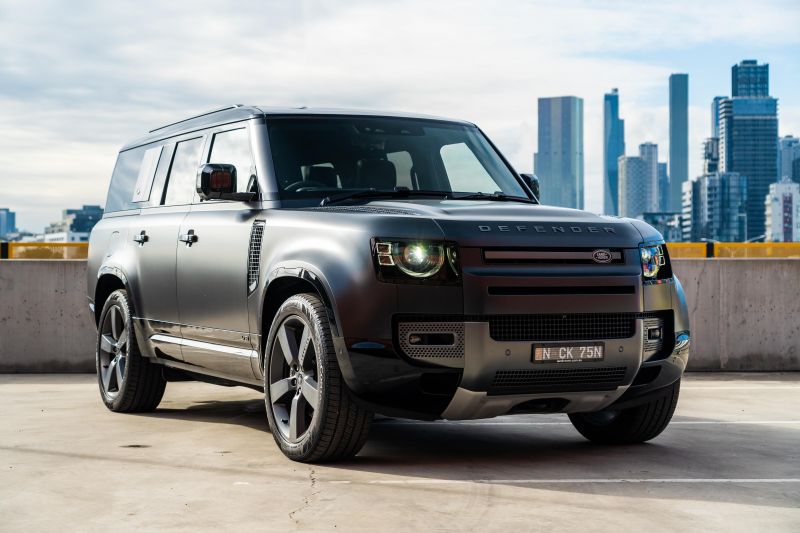Before the OCTA, the Defender 130 V8 was the biggest, baddest Defender you could buy.
Yes, its extended rear overhang is giving a bit of Neville Longbottom, but any Defender will still turn heads if that’s your thing.
Awkward rear quarter view aside, this monstrous off-roader is fitted with an equally monstrous engine… which sadly is slightly detuned here compared to its smaller three-door and five-door siblings.
At $240,000 before on-road costs it’s the biggest and most expensive Defender variant on sale in Australia. Part of that hefty price tag gets you seating for up to eight passengers.
The Defender range is far and away Jaguar Land Rover’s top seller in Australia. In 2023 there were 3846 new Defender units registered in Australia, compared to 2224 Range Rover Sports and then 713 Range Rovers.
While it’s 10 per cent down year to date so far in 2024, the Defender is still leading the way for Land Rover in Australia and outsells the related Discovery by about five-to-one. Crazy.
Retro-inspired looks, a range of powerful engines, and a cult-like following for the iconic off-roader badge no doubt are key contributors to its enduring success.
This is our first bite of the Defender 130, which adds 340mm to the rear overhang for a whopping total length of 5358mm. It’s meaningfully longer than a Toyota LandCruiser 300, Jeep Grand Cherokee L, and the Mercedes-Benz GLS.
Is bigger better in the case of the Defender?

How much does the Land Rover Defender cost?
The V8-engined Defender 130 is a hefty $240,270 before on-road costs, but you can get into the extended off-roader for as low as $126,000. It’s also worth noting we have an MY24 car, with the MY25 range being slightly adjusted.
MY24 Defender 130 pricing:
| Model Variant | $RRP |
|---|---|
| 2024 Land Rover Defender 130 D300 X-Dynamic SE | $126,670 |
| 2024 Land Rover Defender 130 P400 X-Dynamic SE | $134,620 |
| 2024 Land Rover Defender 130 P400 Outbound | $136,870 |
| 2024 Land Rover Defender 130 P500 V8 | $240,270 |
MY25 Defender 130 pricing:
| Model Variant | $RRP |
|---|---|
| 2025 Defender 130 D350 X-Dynamic SE | $130,450 |
| 2025 Defender 130 P400 X-Dynamic SE | $134,556 |
| 2025 Defender 130 P400 Outbound | $136,647 |
| 2025 Defender 130 P500 V8 | $217,282 |
All prices exclude on-road costs
You’ll notice the 2025 range has seen price adjustments, including $13,000 off the P500 V8.
Other key changes include the updated D350 inline-six diesel with more grunt and a range of new options including second-row captain chairs, as well as revised colours and trims. Read more about the 2025 Defender lineup here.
It’s worth noting our test vehicle was fitted with a number of options, bringing the as-tested price to $251,140 before on-road costs – more on the details further down.
To see how the Defender lines up against the competition, check out our comparison tool.
What is the Land Rover Defender like on the inside?
As with the exterior interior changes are subtle.
Like other Defender grades there’s a robust and utilitarian theme which harks backs to Land Rover’s roots, mixed in with the brand’s latest infotainment and display tech to keep it modern and in line with modern expectations.
The 12.3-inch digital instrument cluster and 11.4-inch Pivi Pro touchscreen have been well regarded since launch, thanks to the nice graphics and intuitive functionality.
Land Rover’s software interface has a pretty flat structure and clear labelling to make navigating through menus and applications easy, bolstered by crisp resolution and largely snappy responses.
It’s well featured too, including wireless Apple CarPlay and Android Auto, DAB radio, as well as satellite navigation with traffic information. Compared to more complicated systems from some rival German brands, it’s refreshingly simple and easy to use.
It’s easy to find a comfortable driving position thanks to the fully power adjustable front seats and steering column, and there are plenty of chunky physical buttons and controls for all your vehicle functions.
Land Rover’s commanding driving position is as present as ever in the Defender, often putting you at the same level as truck drivers on the highway. You have a great view of everything in the cabin too.
There’s a range of widgets and displays in the infotainment system and driver’s cluster for general driving duties and off-roading. There are also various modes on hand, and adjustable air suspension which can jack up the ride height significantly.
I’m also a fan of the chunky rotary dials for the climate control which double up as ventilated seat controls. Push to toggle the heated-cooled seats, push again to return to your normal temperature controls.
Build quality feels solid, but this isn’t Range Rover plush, nor should it be. There’s a nice mix of soft-touch surfaces contrasted with more hard-wearing details and materials, and elements like exposed screws, rubberised areas and metal accents.
In fairness, the Defender is meant to carry on the all-conquering go-anywhere spirit of the original. If you want all-out luxury at this price point, Land Rover will gladly get you into a Range Rover Sport.
While there’s been no increase to the Defender 130’s wheelbase compared to the 110, it retains a very spacious and practical second row and gains an even more practical third row courtesy of the longer rear.
The second row’s flat floor and wide bench means three adults should be able to sit across comfortably, with ISOFIX and top tether points helping to cater for little ones. Four-zone climate control and additional device power in the rear is handy, as are the heated outboard rear seats.
Access to the third row is via the folding and sliding second row, though the bigger folding section is on the wrong side for RHD markets like Australia. You can fold each second-row seat independently, but the default is 60:40.
Once you’re in the third row, which is a three-seat bench, the Defender 130 offers a surprising amount of room. The outboard seats will easily accommodate larger adults like 6’1 me, and the middle seat would be pokey but you have good head, knee, and foot room for the class.
You even get heated outboard seats, and the soft-touch surfaces extend to parts of this end of the cabin too. Very impressive… but also somewhat expected of a vehicle costing $250,000.
With all three rows in use the Defender 130 offers a massive 389 litres of cargo capacity, which is more than what’s offered by a Volkswagen Golf. It’s also 100L up over the Defender 110.
Models with eight seats offer 1232 litres with the third row folded, expanding to 2291 litres with the both rear rows down.
Disappointingly, there’s a step up from the rear boot area to the third-row seatbacks and the cargo area isn’t completely flat, but it’s still a massive load area that should prove very useful for owners.
There’s a full-size spare wheel mounted to the tailgate.
| Dimensions | Defender 130 P500 V8 |
|---|---|
| Length | 5377mm |
| Width | 1996mm |
| Height | 1970mm |
| Wheelbase | 3022mm |
| Ground clearance | 220mm – standard |
| Kerb weight | 2670kg |
| Cargo capacity | 389L – 2291L |
To see how the Defender lines up against the competition, check out our comparison tool.
What’s under the bonnet?
The P500 is one of the last times we’ll see Jaguar Land Rover’s 5.0-litre supercharged V8.
| Technical Specifications | Defender 130 P500 V8 |
|---|---|
| Engine | 5.0-litre supercharged V8 |
| Transmission | 8-speed auto Twin-speed transfer box – high, low range |
| Power | 368kW @ 6000rpm |
| Torque | 610Nm @ 2500Nm |
| Drive type | 4WD with 4A mode |
| 0-100km/h (claimed) | 5.7 seconds |
| Fuel type | 95 RON |
| Fuel tank capacity | 90 litres |
| Fuel economy (claimed) | 12.7L/100km |
| Fuel economy (as tested) | 15.6L/100km |
| Kerb weight | 2670kg |
| Towing capacity | 750kg – unbraked 3000kg – braked |
| Towball download | 300kg |
| Gross Vehicle Mass (GVM) | 3380kg |
| Gross Combined Mass (GCM) | 6380kg |
| Ground clearance | 220mm – standard |
It’s a shame the Defender 130’s V8 is slightly detuned compared to the smaller 90 and 110 – the P525 designation on the smaller models means 386kW and 625Nm. Still, a sub-6.0-second 0-100km/h time is pretty swift for something weighing nearly 2.7 tonnes.
Our as-tested fuel consumption was after about a week’s worth of mixed driving including the daily commute to and from the office, as well as some longer-legged highway stints.
To see how the Defender lines up against the competition, check out our comparison tool.
How does the Land Rover Defender drive?
Damn, that’s a big boy.
If the regular Defender 110 was already a big thing, this 130 is on another level. At nearly 5.4 metres long, it’s like driving a long-wheelbase limo that rides 220mm in the air. It’s also nearly 2.0m tall.
The satin grey paint finish and darkened exterior accents makes this imposing to look at even standing still. And with the burble from the supercharged V8 under the bonnet, it has the driving character to match… well, mostly.
In normal driving it’s often hard to tell the Defender V8 is supercharged. The 5.0-litre unit has a linear and rev-happy nature that makes it almost perform like a naturally aspirated engine, though there’s a laziness dialled in down low that can sometimes see the Defender lurch forward when peak torque comes online at 2500rpm.
To get more aggressive response and a more pronounced growl from the V8, flick the gear selector into S and the Defender will hold gears longer and downshift earlier, getting you into that 3000-4000rpm band where you get a bit more of that soundtrack.
While it has a noticeable V8 growl as the revs climb, it’s not as sonorous as some other JLR products like the F-Pace SVR and outgoing Range Rover Sport SVR. It’s lacking the bi-modal exhaust of those models, perhaps.
At full noise this thing hauls. The nose points to the sky and it hurtles towards the horizon. I’m not a fan of the sound augmentation in the cabin, because it can sound a little contrived. Still, it’s a better sound than the diesel.
Otherwise the dynamics are all pretty typical Defender. It’s tall, it’s heavy, and it’s big – and feels it. Particularly in extended 130 guise, the Defender feels like a proper tank on the road.
Good or bad thing? Well, it depends. Yes there’s decent visibility out the front and sides but if you’re a nervous parker the rear of the Defender 130 will feel like it’s in a different suburb and it’s too long for most parking spots.
You also need to account for the spare tyre which rudely doesn’t have the reversing camera attached. Instead, you’re either looking above through the digital rear mirror or from below via the reversing camera feed.
Thankfully the surround cameras with 3D simulation of the Defender help. But an ideal urban runabout this is not.
The light steering and hefty proportions means it’ll never feel particularly dynamic, but it’s a bit of fun chucking the 130 around and leaning about, then blasting forward.
It generally feels pretty secure and planted, and there’s good grip from the large footprint. Push it to its limits and it’ll just understeer.
This is at home on the open road cruising between town centres. It’s very comfortable on the move and just powers through miles.
Overall refinement is decent but not standout, particularly at this price point. The upright profile, airy cabin and more utilitarian interior means there’s a bit of echo and booming from road and wind noise, but it’s far from unrefined.
You do occasionally get the odd creak from some of the seals and interior bits over sharp hits and driveways, which is pretty common for these more rugged and focused off-roaders.
Land Rover has kitted the Defender out with all the necessary assistance systems to keep you on the straight and narrow, including adaptive cruise control and lane keep assist – though there’s no active lane centring.
Blind-spot monitoring and rear cross-traffic alert are also helpful given the Defender 130’s massive length, and there are surround parking cameras complemented by sensors.
If there’s one complaint about the Defender’s assistance suite, it’s that – like other JLR products I’ve tried recently – the speed limit assistant constantly beeps and bongs, much like we’ve complained about in Hyundai-Kia cars.
This is a requirement in Europe; the system chimes when the speed limit changes, and if you’re going over the signed limit. It’s incessant, and even though the actual sound isn’t that grating it’s just constantly going off.
Thankfully, Land Rover has a dedicated assistance button on the steering wheel allowing you to turn all systems off with a couple of presses or engage a ‘Custom’ assistance suite which is as simple as leaving the speed sign assist off and everything else on.
We didn’t take this particular Defender off-road, but the smaller 90 and 110 have impressed us in the past with their capability off the blacktop – as you’d expect from a vehicle wearing ‘Land Rover’ and ‘Defender’ badges.
The Defender 110 D300 actually won the off-road portion of our recent 4WD SUV Mega Test, with the following feedback from Founder Paul Maric:
“It didn’t roll back at all on the rollers, with the active central and rear differential immediately locking to drag it up the hill with no fuss.
“Wheel articulation was excellent over the offset moguls, and the Defender passed the door test with flying colours. Paul did notice a squeaky seal on one of the doors over uneven surfaces, however.
“Its 4WD systems dealt with two wheels being in the air effortlessly, with almost no wheel spin or jerking on the way out of the ruts. The added articulation thanks to air suspension meant that the wheels rarely left the ground.
“As for the hillclimbs? Mogul Mountain was dispatched with a minimum of fuss, and it scrabbled up Gravel Mountain on the third attempt – with more throttle than its first attempt and the air suspension set to its ‘Normal’ height the car made it to the top of the hill. An upshift at the top of the hill killed some momentum.
“Hill-descent control kept the car’s considerable mass in control nicely. It’s worth noting the Defender was the first car up Gravel and Mogul Mountain.”
It’s worth noting the Defender 130 has a worse departure angle than the 110, quoting 28.5 degrees in the suspension’s off-road setting compared to the Defender 110’s 40-degree claim. Approach and ramp over angles remain the same as the 110, however, at 37.5 and 27.8 degrees respectively.
The air suspension is capable of raising the Defender up by nearly 70mm, with the quoted running clearance 291mm in the system’s off-road setting.
| Off-Road Specifications | Defender 130 |
|---|---|
| Ground clearance | 220mm – Standard setting 291mm – Off-Road setting |
| Approach angle | 37.5 degrees |
| Departure angle | 28.5 degrees |
| Rampover angle | 27.8 degrees |
What do you get?
The V8 sits at the top of the Defender tree across 90, 110 and 130 body styles.
Defender 130 V8 standard equipment:
Exterior
- V8 badge
- Quad exhaust pipes
- Shadow Atlas skid pan – front, rear
- Shadow Atlas grille
- Shadow Atlas badging
- Black brake calipers
- Signature graphic – with interior storage
- Heated windscreen
- Heated washer jets
- Heated, electric side mirrors
- Approach lights
- Auto-dimming driver side
- Heated rear window incl. timer
- Third row fix panoramic glass
- Front fog lights
- Auto headlight levelling
- Darkened tail lights
- Solar attenuating windscreen
- Soft close tail door
- Black exposed rear recovery eyes
Exterior lighting
- Headlight power wash
- Puddle lights
- Auto headlights
- Auto wipers
- Rear fog lights
- Follow me home lighting
Interior
- Heated steering wheel
- Electrically adjustable steering column
- Sunvisors with illuminated vanity mirrors
- Bright metal pedals
- Configurable cabin lighting
- Loadspace cover
- Rubber cabin flooring
- Footwell lights
- Satin Chrome gearshift paddles
- Illuminated metal treadplates incl. V8 badging
- Four-zone climate control
- Ebony Windsor leather, Kvadrat seats
- Nubuck edged carpet mats
- Air Quality Sensor
- Cabin Air Purification Plus
Infotainment
- Meridian surround sound system
- Online Pack with data plan
- DAB radio
- Apple CarPlay, Android Auto – wireless
- Head-up display
- 12.3-inch Interactive Driver Display
- 11.4-inch Pivi Pro touchscreen infotainment
- 12V socket in loadspace
Convenience
- Domestic plug socket
- ClearSight digital rear-view mirror
- Keyless entry
- Wireless phone charging
Towing
- Advanced Tow Assist
- Trailer Stability Assist
Transmission and Dynamics
- AWD
- Twin-speed transfer box – high, low range
- Electronic air suspension
- Adaptive dynamics – damping
- Electronic Active Differential
- Torque vectoring via braking
- Terrain Response 2 with Dynamic Program
- Configurable Terrain Response
- All Terrain Progress Control
Driver Assistance
- 3D surround camera
- Wade Sensing
- Driver condition monitor
Options
The following optional features were fitted to our test vehicle.
- Carpathian Grey Premium Metallic: $1040
- Satin protective film: $7040
- Tow hitch receiver: $1430
- Front undershield: $1040
- Rubber loadspace mat: $320
Price as tested: $251,140 plus on-road cosys
Is the Land Rover Defender safe?
The Defender 110 wears a five-star ANCAP safety rating for all variants bar those with the V8 engine. Defender 90 and 130 body styles remain unrated.
In 110 guise the Defender managed 85 per cent for adult occupant protection, 88 per cent for child occupant protection, 71 per cent for vulnerable road user protection, and 76 per cent for safety assist.
Standard safety equipment includes:
- Adaptive cruise control
- Autonomous emergency braking (AEB)
- Pedestrian, Cyclist detection
- Junction assist
- Blind-spot monitoring
- Driver attention monitoring
- Lane keep assist
- Parking sensors – front, rear
- Rear cross-traffic alert
- Safe exit alert
- Surround-view cameras
- Traffic sign recognition
How much does the Land Rover Defender cost to run?
Land Rover covers its vehicles with a five-year, unlimited-kilometre warranty in Australia.
| Ownership Program | Defender 130 V8 |
|---|---|
| Warranty | 5 years, unlimited kilometres |
| Roadside assistance | 5 years |
| Service interval | 1 year or 26,000km |
| Service pricing | $3750 – 5 year service plan |
CarExpert’s Take on the Land Rover Defender
I’m a big fan of the Defender, but the 130 particularly in V8 guise seems a little silly.
The big engine seems like excess for the sake of it, and unless you’re looking to have one of the only V8-powered eight-seaters on the market (you can get three base Nissan Patrols for similar coin), I’m not sure the 130 V8 justifies the $15,000 extra spend over the 110 with the same engine but more power.
At nearly 5.4 metres long and 2.0 metres wide it’s too large for cities, and just subjectively the rear end just looks a little awkward. The proportions of the 110 are much more conventional, and there’s a cool factor about the three-door 90.
Still, this is quite a bit cheaper than the Mercedes-AMG G 63 (from $368,400) which doesn’t offer three rows of seating in any variation. Could buy a Defender V8 and a standard Defender for similar spend to the Mercedes.
It’s the bonkers factor that gives the supersized Defender its charm. The imposing size and sound gets you noticed, and there’s still something very cool about the distinctive design and utilitarian interior.
There’s nothing else really like it at this end of the market, though if you’re getting the Defender 130 I’d argue you’d be better served by the ‘base’ D350 diesel with some choice options if you’re looking to take up to seven people with you on your off-road adventures.
At least the MY25 version gets a handy $20,000+ price cut if you can afford the luxury – that buys a lot of fuel…
Click the images for the full gallery
MORE: Buy a Land Rover Defender
MORE: Everything Land Rover Defender
















